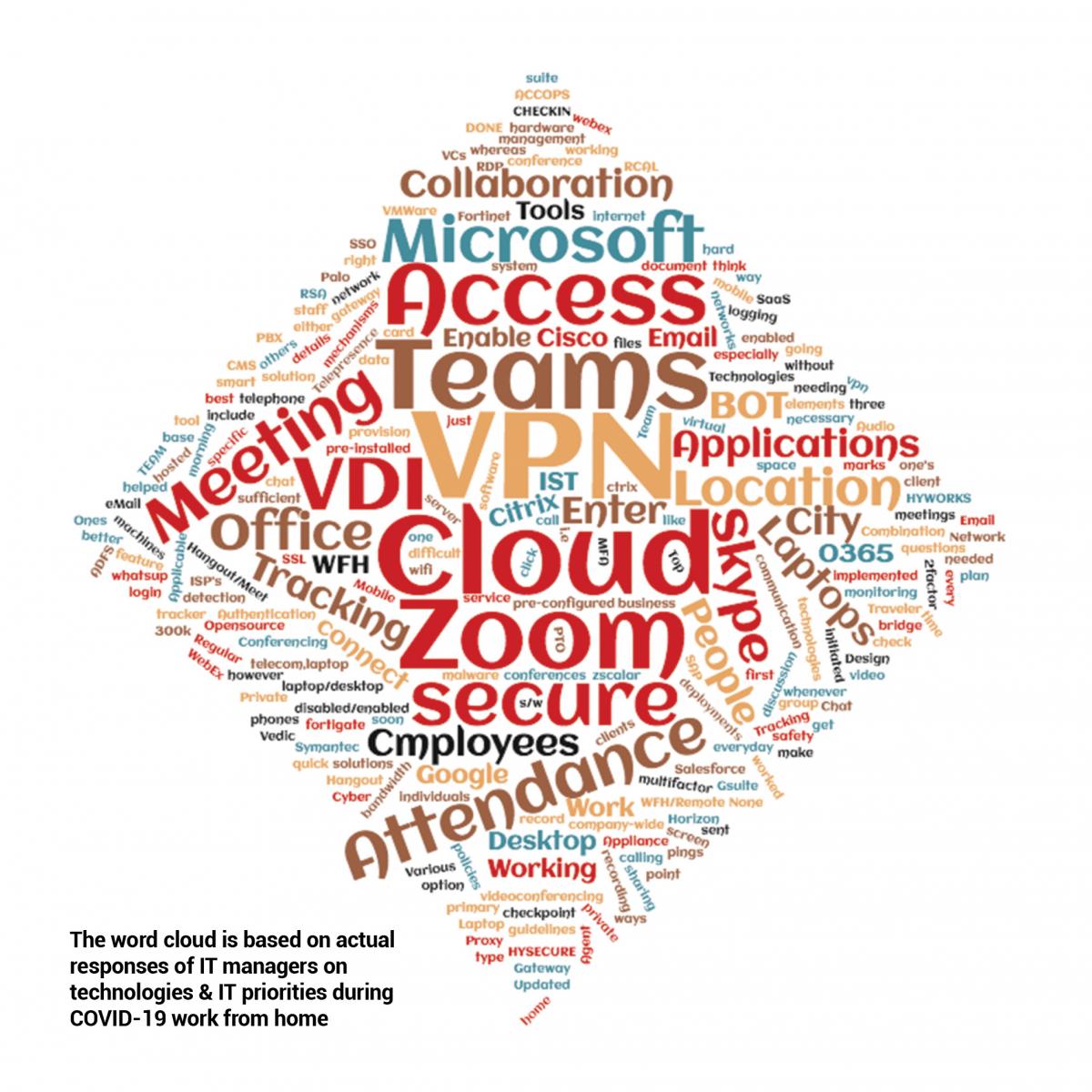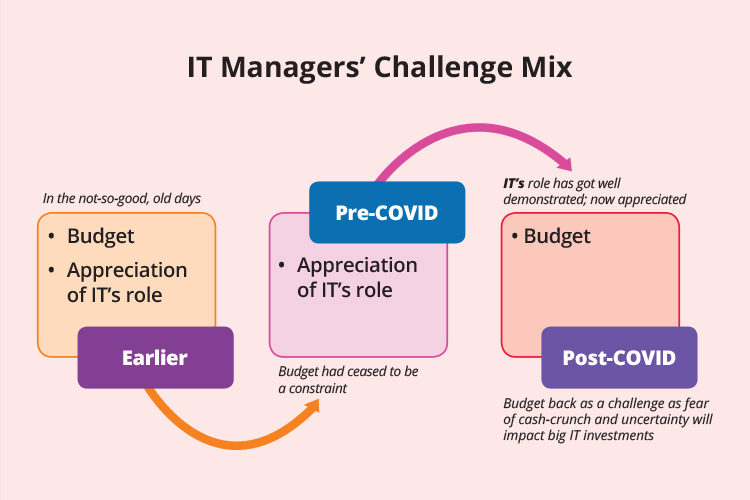
Most of you would have received this WhatsApp joke about COVID-19 being a far more effective driver of digital transformation within enterprises than either the CIOs or CEOs. The joke has an element of truth in it, like all good jokes do.
Executives who were finding all the excuses not to use spreadsheets on their computers are now working on collaborative documents quite smoothly. Organizations in certain industries who maintained that remote working was not just possible for their business, have most of their ‘working’ executives working from home. In other words, COVID-19 did make organizations realize the value of digitalization, automation and IT in general. This is likely to accelerate digitalization.
We discuss these in social media; publications carry articles on this; self-styled experts project this as a big change; analysts, as always, throw in a few numbers, hoping for some good coverage.
But there are two gaps—or should we say fallacies--in this COVID-19-enabling-digitalization story.
One, the fallacy that COVID-19 made it happen.
Without taking credit away from COVID-19, it must be told in no uncertain terms that this change of attitude did not happen by itself. It happened because senior executives ‘experienced’ that it is possible to work remotely without glitches. Just imagine—if this switch to WFH would have resulted in major breakdowns, major service disruptions, large-scale security attacks! Would the organizations still have got ‘convinced’ about the value of digitalization?
They got convinced because they found a smooth experience. COVID-19 did not do that. IT managers did. Let there be no confusion—this was enabled by the IT managers, against all odds—in a matter of hours or max a matter of days, most certainly not in weeks. They kept the business running.
The second fallacy is that all this will automatically lead to large-scale digitalization. This is a dangerous over-simplification. Appreciating the ‘utility’ of IT—an executive was already refusing to call it value—and making large investments in digital are not synonymous. Not in normal conditions, let alone in such an uncertain, cash-starved business situation like today’s, when many organizations are operating at a fraction of their capacity.
We must examine the future—whatever little we can do—keeping these two false narratives in mind.
The value of IT managers
In recent years, as the decibel level about technology’s role in business was rising, it was accompanied by a strange, supplementary narrative—that technology is too important to be left to techies.
This was based on half-baked knowledge about how technology can add value to business. It started in the mid-2000s, when SaaS as a software delivery model became popular and since it was a subscription-model, the spend on applications came under operational expenditure, prompting the business units to bypass IT by going for apps, purely by their promised functionality, being happy that they have speeded up things. It took almost a decade to understand that there is something called integration with enterprise systems, seamless data movement, and of course security.
The next big driver of this tendency was what was called consumerization of enterprise IT—users demanding what they wanted. This was a take-off from the SaaS trend but was broader as it included using own devices and expecting personal application type experience in business applications that led to user experience getting significantly better, and executives being able to do much more without asking the IT guys. That resulted in a (false?) sense of independence.
On their part, IT vendors fueled it by trying to reach out to functional heads. Even network security and infrastructure vendors wanted to talk to CEOs.
As technology played a bigger role in business, major management gurus and think tanks integrated technology to their discourses on economy, public policy and business. The World Economic Forum (WEF) had tech-related themes in multiple of their annual meetings at Davos. The CEOs and board members got convinced that they could do much more with technology. Blockchain, AI, IoT, Big Data became business buzzwords, and the CXOs expected ‘use cases’ for these technologies in their businesses. The IT managers were seen by some as mere nuts-and-bolts guys.
When a situation came, it is the nuts and bolts guys who saved the day. Not data or DevOps but IT infrastructure and security managers ensured that businesses ran with secure access to employees and with a reasonable experience.
This disruption—the first real one since we have started using it as a business jargon—if anything, has reinforced the value of enterprise IT.
They did it
Work from home—the three words sound so deceptively simple. But it was anything but simple for the IT managers, especially in industries that were not used to this mode of working. And this simple change in working style could change many things—corporate practices, culture, strategy, ecosystem, and many more.
But first things first. Before getting into the future, it is imperative that we touch upon, albeit briefly, what were the challenges faced by the IT managers and what technologies they used to make it possible.
In a research among IT managers, we examined these questions. We sought responses from 44 IT managers from diverse industries and at various levels – mid level to senior level. to get into the bottom of it. Even as these IT warriors were still figuring out how to take COVID-19 head-on to make their companies—and indirectly the nation—keep running, they were enthusiastic in sharing their experiences and the learning.
We briefly summarize the findings here. Most IT managers pointed to a combination of one or more of the five below-mentioned tasks:
- They ensured that everyone has a secure access to all applications that they needed to access. That is why VPN features such overwhelmingly in the responses. Many sectors used to remote working, it was familiar territory but they still had challenges such as allowing access to specific applications to a wider base of users and ensuring that the infrastructure supports everyone accessing remotely.
- They also ensured that those who worked on desktops are given laptops. Many turned to VDI too. Some smaller companies even went for a non-technical solution: they allowed their employees to take home the desktops.
- The next step was to enable collaborate working and videoconferencing. A few had software like GoToMeeting and WebEx. Microsoft Teams is also popular. But what emerged as a cult application in the time is Zoom, which has now become a household name, even for non-business applications.
- Of course, WFH required extra security features. That were enabled by the security teams.
- Some organizations where there was need to access bandwidth hungry applications, the organizations had to ensure extra bandwidth and Internet access for the employees. Employees were given dongles, data cards and often, it involved a non-technical solution like reimbursing the access fees.

The battle was decisively won. But what about the war?
Short-term challenges
We spoke to about a dozen CIOs in businesses where digitalization was not exactly a given—businesses like steel, heavy engineering, chemicals, textiles, cement and pharma.
Most CIOs agreed that the naysayers to technology have now been convinced about its ability to make businesses run. The CIO of a large company described how some CXOs, when they had to work from home, struggled because they did not even know the use of basic applications like Excel, which their secretaries used for them. “But some of them, thanks to the post COVID-19 reality, are now not just able to use collaborative software but are even excited to discover newer features—starting from screen sharing onwards,” he said, a sense of happiness and satisfaction oozing out from his voice.
But there are challenges.
Large projects have been stalled. Some of the new or planned projects have been abandoned. And the focus has shifted to cost-saving.
This is because almost all companies—which are operating at anywhere between 30-50% of their capacity, because of the lockdown, expect that there will be a liquidity/cash flow issue going forward, because of both volumes dropping significantly and many of the smaller distributors defaulting on credit. While they can plan for the first one, the exact magnitude of impact of the second factor is still unknown.
“The mood is cautious. And quite rightly so,” says a CIO of a group company in a diversified group. “Budgets will have to be reworked, you cannot pretend that nothing has happened,” adds Jitendra Singh, CIO of JK Cement. Atul Govil, Chief Transformation Officer of India Glycols says, “It is difficult to think of major new investments now.”
In other words, while there has been an increase in appreciation of role of IT in business, we are not going to see huge investments flowing in, thanks to budget constraints. While there is no estimate yet, this is going to be the biggest downturn we have seen in our lifetime.
The diagram shows how the IT managers’ challenge has changed over time—especially pre- and post-COVID.

Does it mean that companies will stop investing completely, at least in the short run?
Not really. It is big money that will be elusive. That is not just because of the cash crunch. It is also because of drastic changes in operational models expected post recovery.
Yet, one thing will define this recovery phase. As companies realize the small but impactful gaps in their processes, they will try to close those gaps. This means smaller, tactical investments will be made that give an immediate return in terms of efficiency, lesser utilization of manpower or safer operations for people.
Take Spoton Logistics, a tech-leveraged express logistics company that is growing fastest in the industry and is challenging the biggies in the game. It has already implemented a contactless PUD solution to minimize, if not eliminate roughly 11,000 human touch points daily using technology. “With the help of different platforms like Web Shipping Tools, Self Service Portal, API Integration and Manual Con Note Elimination, customers can book and generate and print the e-Con Note or e-labels and provide to the pickup executive to minimize paper exchange and processing time,” says Satya Pal, AVP - Business Engineering, Spoton Logistics.
As discussed, many companies have already started digitalizing paper approval processes. As companies quickly automate some of the processes and as work from home continues for a while, security is in the minds of most CIOs, though many hasten to clarify that they are not looking for organizational security overhaul.
But ‘secure access’ is clearly an immediate focus, based on the learnings that they have had.
When it comes to manufacturing, CIOs identified a number of business challenges in the recovery phase. Most of them could be put into three baskets:
- Liquidity challenges
- Supply chain challenges
- Managing human resources
And they are not exactly mutually exclusive. And all the three have implications for IT—both in terms of expectations from it and in terms of budget available. Take liquidity challenge. As articulated by several CIOs, large projects are kept in abeyance for the time being. But there are discussions too around how IT can help in minimizing the impact of cash flow. In supply chain, the focus is not just in automating approvals and other manual processes, but also to ensure that human beings are safely deployed.
Similarly, when it comes to people’s work, WFH is going to stay, if not fully, but significantly. In the last few years, many large companies like Microsoft and Cisco have created a major focus on Future of Work. But the way COVID-19 has accelerated the movement towards digital working, even these companies would never have imagined. Today, almost all companies—more so the lesser digitalized manufacturing companies—have to realign many resources to make that happen.
The long shot
What about post-recovery?
Well, to put it straight, no one has an iota of an idea what it will be like.
But based on the analyses globally and CIOs’ inputs, some of the areas that will be significantly impacted will be the following:
- Huge change in distribution of workforce: While that itself is a no-brainer—TCS has already announced that in two years, 75% of its workforce will work from anywhere—the implication for it is still lesser understood. It will impact information storage and access, culture, events, security, real estate, transportation and many, many other aspects of business. And in each—and we emphasize on each—of these areas, technology will play a major role in making the shift happen, some of which cannot even be envisaged now. It will not be surprising if this becomes the biggest innovation plane, with a number of startups.
- Industry 4.0: What we in India just keep debating, China has already done. The typical Indian narrative is the West is going for automation because it does not have people and it is a compulsion. But China has shown that even in the thick of crisis, large plants were run by less than 20% of people who run a similar size of plant in India. That is not just safe. That is hugely efficient. How can you compete with companies who have that kind of efficiency? Of course, the role technology will play there does not need elaboration. It is an out and out technology game.
- New way to look at BCP: The Business Continuity Planning (BCP) so far has been focused on protecting data repositories and infrastructure. They were planned to protect against not just human threats but even natural disasters like cyclones, floods and earthquakes. The focus was data center. In COVID-19, data centers were hale and hearty. It is people who needed secure access. Beyond the details of difference, it teaches one big lesson. BCP is a risk planning, not a process planning. Processes are the means of achieving. We will see huge shift in the way organizations do BCP.
- Security getting bundled: Interestingly, in our research, we would hear the adjective, at least five times more than the noun. Everyone was talking of secure access, secure application, secure network, secure cloud—very few about security. The expectation is: whoever provides these components has the onus of making them secure. Organizations will focus on the core part of their data protection. This will see a huge shift in security planning and the role of chief information security officers.
As of now, we know little to be talk anything more specific.
But one thing is for sure. There will be new times. And there will be new rules of the game.
Some of them will be drastically different. Many organizations will also fail to assess what is a long-term change and what is a short-term one. This confusion and uncertainty mean long-term investments—including technology investments—will not be made in any transformational areas.
Yet, with better appreciation of IT’s ability to make an impact, in most projects with visibility, technology would be required to play a major role.
For the IT managers, this means a number of short-term investments, distributed over many areas with little investment in long-term projects. Vendors will continue to pitch for long-term commitments, giving their own logic.
Digital transformation, platform building, long-term planning will be overshadowed by quick ROI investments, as in small companies. This will turn the technology investment strategy which has become fashionable in the last few years, upside down.
That precisely will be the war many IT managers will have to fight—not just during COVID-19 or the recovery phase but for some time well beyond the recovery phase.

 In
In
Add new comment